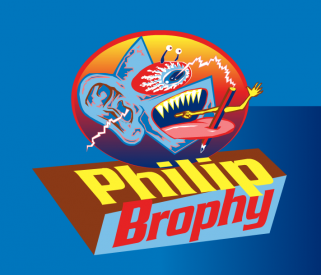Working since the late 1970s Brophy’s extensive creative output has covered a huge array of activities from work as an artist, film director, curator and author to collaborative and solo projects as a musician, composer, sound designer and graphic illustrator. Brophy’s aesthetic is an unlikely mix of pop art gloss and horror film grime that is as subversively humorous as it is genuinely unnerving.
Brophy’s early works in the late 1970s and early 1980s combined music performance and film and video production. Brophy was the founder of the band →↑→ [Tsk Tsk Tsk] with Ralph Traviato and Leigh Parkhill. Although numerous other musicians and artists subsequently joined the band on a permanent or just-passing-through basis – and included such luminaries as David Chesworth, Maria Kozic and Jane Stephenson – the band was very much Brophy’s brainchild, and thus a canny meeting of musical style and pastiche adjoined to post structuralist theory. A typical →↑→ record and accompanying video could be a record and a video as much about disco as it could be be a post modern deconstruction you could dance to.
Super 8 films made by Brophy and band collaborators examined tropes of musical presentation prevalent in the then-emerging genre of rock clips, or recontextualised and updated the approach to film narrative, experimentation and documentation pioneered by Andy Warhol in the 1960s and 70s. Films such as Romantic Story (1981), No Dance (1982), Muzak: Rock and Minimalism (1983) and Caprice (1983) are typical examples of this approach and are remarkable for their sophisticated conceptual ambition on very low budgets. The group’s film The Opening of the 1980 Moscow Olympics as Televised by HSV Channel 7 (1980) – with its use of long takes of Olympic games coverage refilmed from a television screen – anticipated much of the film and video culture of appropriation that would emerge in the following decade.
Brophy’s two-screen solo video work Club Video (1985) is indicative of his continuing interests and methodological approaches to the study of the effects of sound and image montage. Described by Brophy as a “reconstruction of fragments from records to produce a homogonous whole rather than a heterogeneous whole” Club Video consisted of sequences from films featuring the performance of music re-scored by Brophy with a disco or “club” music feel. Later video works such as Evaporated Music 1 (2000-04) and Evaporated Music 2 (2008) continued this experimentation to bizarre and uncanny effect. Evaporated Music 1 took video clips by Elton John, Billy Joel, Phil Collins, Gloria Estefan, Celine Dion and Mariah Carey, removed the music and substituted cued sound effects to highlight the movement of water, a swing, a closing door and other incidental visual features otherwise stripped of sonic presence in the original. For Evaporated Music 2 Brophy took its visuals from an unnamed teenage music/drama TV program featuring the performance of a band and then completely substituted metal music and lip-synced lyrics. In both works the overall effect was mesmerising and utterly disturbing.
Recurring throughout Brophy’s work has been an interest in theories of the abject and the depiction of the human body in pornography, science fiction, horror and contemporary art. The Body Malleable (2004) brought these ideas into a single installation piece. Consisting of an interface between audience and a screen, the visitor was confronted with a human-like orifice sculpted from plastics that recalled the design of personal computers or sex toys. When a finger was inserted into the orifice the video projection morphed between abstracted vaginal, penile and anal body-like forms as an accompanying soundtrack shifted in tone and timbre. The Body Malleable was first exhibited at the Australian Centre for the Moving Image in 2004 and then subsequently at a number of venues including the Erotic Art Prize, Perth, 2006, the Anne Landa Award, Art Gallery of NSW, 2006 and at the National Museum of Art, Osaka, Japan, 2007.
In 1988 Brophy directed the 57 minute short film Salt, Saliva, Sperm, Sweat, an episodic narrative of a day-in-the-life of an office worker told via his ingestion or excretion of the titular substances. Screened at the 1988 Melbourne International Film Festival the short was described as film as much about the understanding of film as it was an experiment in shlock-horror effects. The MIFF catalogue notes asked - “What motivates society to embrace a cinema dominated by elements of sex, violence, horror and terror? [...] Salt, Saliva, Sperm and Sweat looks at how these explosive elements form an integral part of cinema today. Stylization, repetition, manipulative mood-swings, pithy, theoretically fuelled titles, stark hyper-lighting and the tension between what is 'meant' and what is 'filmed' are only some of the strategics employed to inform, engage and destabilize the viewer.” Brophy’s debut feature film Body Melt [1993] explored similar conceptual territory albeit within a more conventional generic narrative structure - police investigate a car accident that leads them via a series of bizarre and unlikely plot twists to a doctor whose experiments in human mutation hide under the guise of a “health farm”.
Recent Brophy projects such as The Sound of Milk [Prologue] [2004] and Northern Void [2007] – the latter made as the sound art duo Ph2 (Brophy with Philip Samartzis) – continue to experiment with film narrative, genre tropes and music-sound-montage relationships, while gallery multiple-screen installation pieces such as 10 Transforming Youths and 10 Flaming Youths [both 2010] unite Brophy’s prodigious talents as a director, producer, sound-designer and graphic designer.
Brophy is the author of numerous books, journal and magazine articles on a range of subjects including video art, music, film sound and cinema studies. His work includes editing three volumes of Cinesonic [Australian Film TV & Radio School 1998-2001] and writing that includes the publications 100 Modern Soundtracks [BFI London 2004], 100 Anime [BFI London 2005] and Priscilla [Currency Press 2008].





